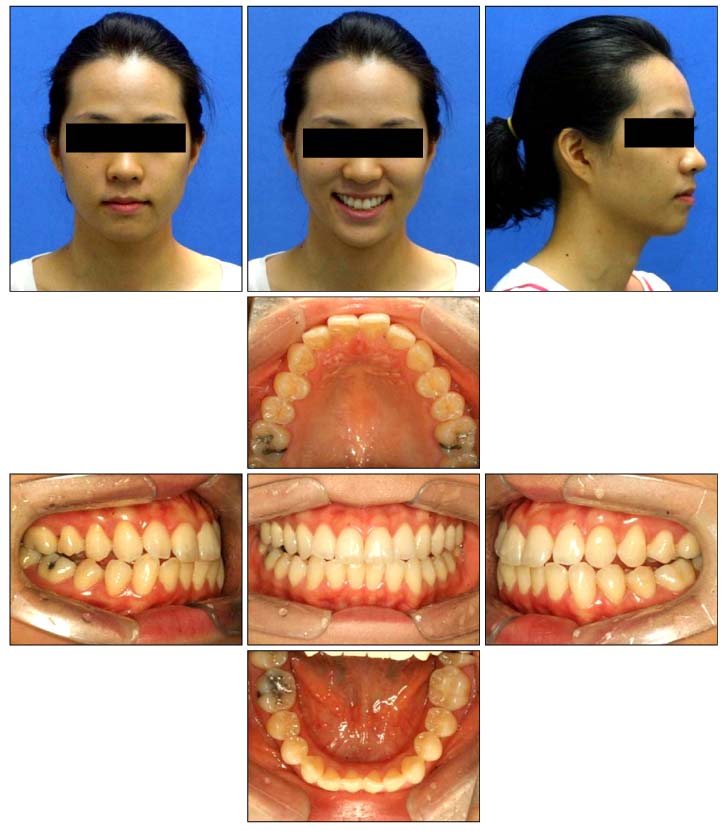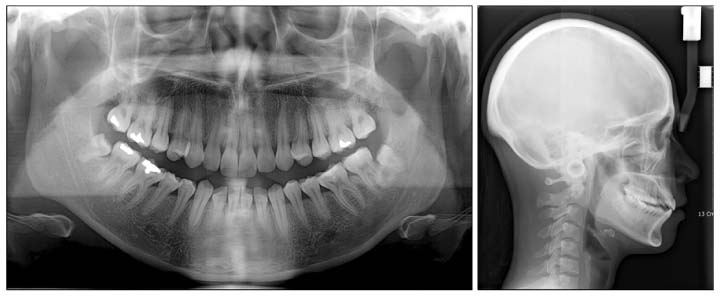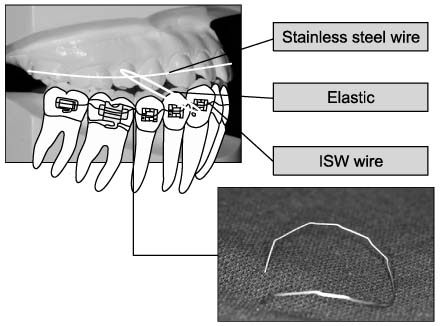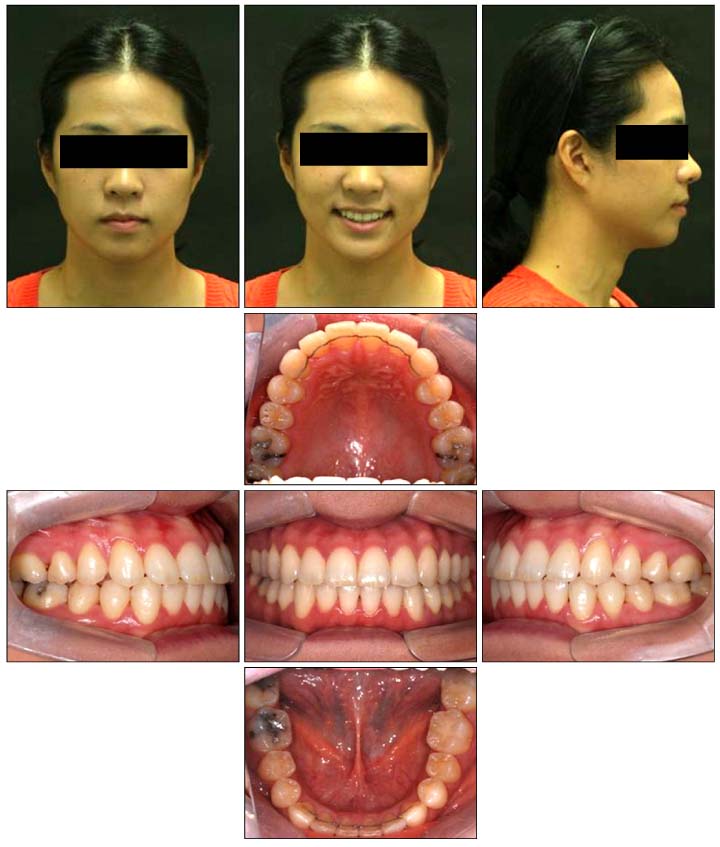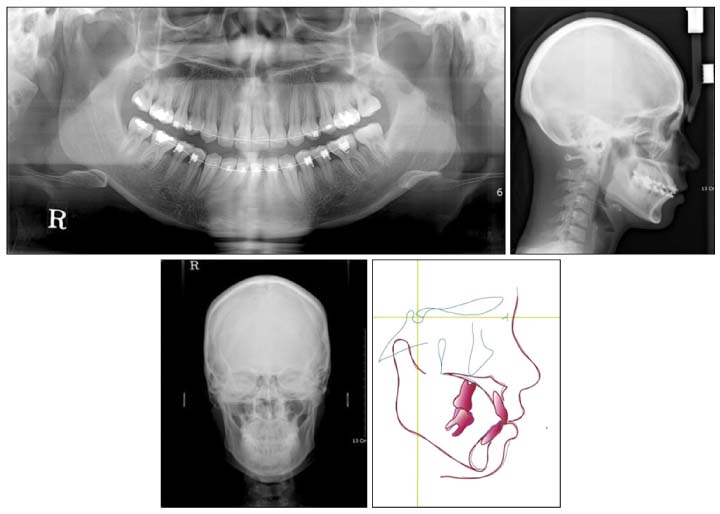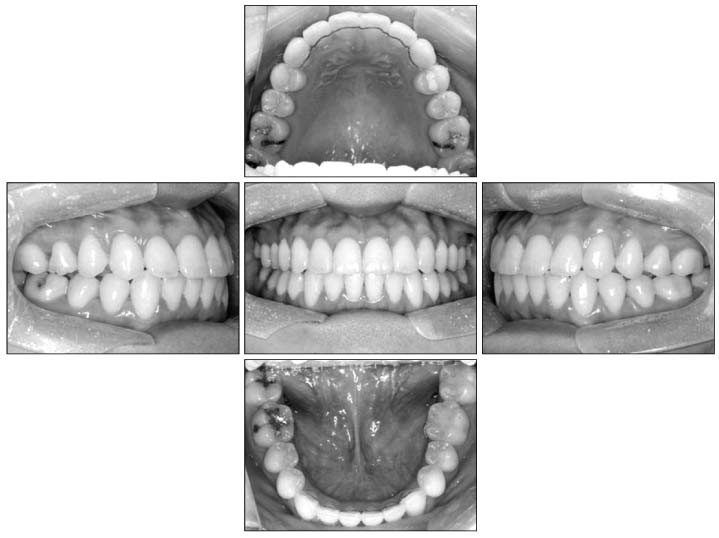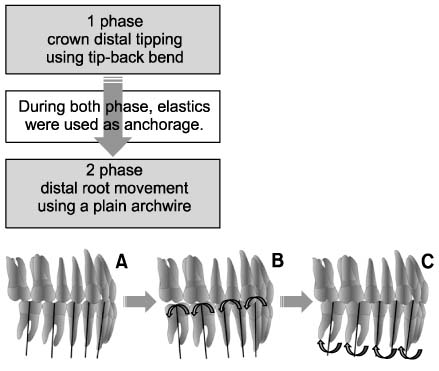Korean J Orthod.
2011 Aug;41(4):297-306. 10.4041/kjod.2011.41.4.297.
Non-extraction treatment in Class III malocclusion by using improved superelastic NiTi wire
- Affiliations
-
- 1Department of Orthodontics, College of Dentisrty, Yonsei University, Korea. jungcha@yuhs.ac
- KMID: 2274264
- DOI: http://doi.org/10.4041/kjod.2011.41.4.297
Abstract
- Nonextraction camouflage treatment in mild Class III malocclusion is achieved by backward movement of the lower dentition and forward movement of the upper dentition. Many camouflage treatment modalities have been used for distal tipping and distal movement of mandibular posterior teeth. The amount of distal movement of mandibular dentition can be improved in cases of severe crowding, even without the patient's cooperation, by using miniscrews for anchorage. However, miniscrew insertion may be unsuccessful, and it may contact the adjacent root because of the distal movement of dentition. Distal tipping of mandibular dentition can be achieved using multiloop edgewise archwires and intermaxillary elastics. However, the complexity of this wire design causes discomfort to patients. Recently, a new treatment using improved superelastic NiTi wires (ISWs) and intermaxillary elastics has been introduced. ISWs can deliver orthodontic force more effectively, and their use with molar tip-back treatment has several advantages-this approach is effective, simple, and easy to use and reduces patient discomfort. The aim of this study was to report a case of camouflage treatment using ISW with tip-back and intermaxillary elastics for distal tipping of mandibular posterior dentition and to evaluate the effectiveness of this treatment in a clinical setting.
Keyword
Figure
Cited by 2 articles
-
Reader's Forum
Korean J Orthod. 2020;50(3):155-156. doi: 10.4041/kjod.2020.50.3.155.Three-dimensional analysis of tooth movement in Class II malocclusion treatment using arch wire with continuous tip-back bends and intermaxillary elastics
Ji-Yea Lee, Sung-Kwon Choi, Tae-Hoon Kwon, Kyung-Hwa Kang, Sang-Cheol Kim
Korean J Orthod. 2019;49(6):349-359. doi: 10.4041/kjod.2019.49.6.349.
Reference
-
1. Chang YI, Moon SC. The diagnosis and treatment of anterior openbite malocclusion. Korean J Orthod. 1998. 28:893–904.2. Sugawara J, Daimaruya T, Umemori M, Nagasaka H, Takahashi I, Kawamura H, et al. Distal movement of mandibular molars in adult patients with the skeletal anchorage system. Am J Orthod Dentofacial Orthop. 2004. 125:130–138.
Article3. Iramaneerat K, Hisano M, Soma K. Dynamic analysis for clarifying occlusal force transmission during orthodontic archwire application: difference between ISW and stainless steel wire. J Med Dent Sci. 2004. 51:59–65.4. Liaw YC, Su YY, Lai YL, Lee SY. Stiffness and frictional resistance of a superelastic nickel-titanium orthodontic wire with low-stress hysteresis. Am J Orthod Dentofacial Orthop. 2007. 131:578e12–e18.
Article5. Miura F, Mogi M, Ohura Y. Japanese NiTi alloy wire: use of the direct electric resistance heat treatment method. Eur J Orthod. 1988. 10:187–191.
Article6. Hisano M, Chung CR, Soma K. Nonsurgical correction of skeletal Class III malocclusion with lateral shift in an adult. Am J Orthod Dentofacial Orthop. 2007. 131:797–804.
Article7. Garrec P, Jordan L. Stiffness in bending of a superelastic NiTi orthodontic wire as a function of cross-sectional dimension. Angle Orthod. 2004. 74:691–696.8. Daher W, Caron J, Wechsler MH. Nonsurgical treatment of an adult with a Class III malocclusion. Am J Orthod Dentofacial Orthop. 2007. 132:243–251.
Article9. Gonzalez B. Non-extraction treatment of a Class III skeletal case. Int J Orthod Milwaukee. 2009. 20:15–21.10. Kuroda S, Yamada K, Deguchi T, Hashimoto T, Kyung HM, Takano-Yamamoto T. Root proximity is a major factor for screw failure in orthodontic anchorage. Am J Orthod Dentofacial Orthop. 2007. 131:4 Suppl. S68–S73.
Article11. Baek SH, Shin SJ, Ahn SJ, Chang YI. Initial effect of multiloop edgewise archwire on the mandibular dentition in Class III malocclusion subjects. A three-dimensional finite element study. Eur J Orthod. 2008. 30:10–15.
Article12. Yang WS, Kim BH, Kim YH. A study of the regional load deflection rate of multiloop edgewise arch wire. Angle Orthod. 2001. 71:103–109.13. Moon SC, Chang YI. A cephalometric evaluation of anterior openbite malocclusions treated by multiloop edgewise archwire technique. Korean J Orthod. 1993. 23:565–606.14. Horiuchi Y, Horiuchi M, Soma K. Treatment of severe Class II Division 1 deep overbite malocclusion without extractions in an adult. Am J Orthod Dentofacial Orthop. 2008. 133:4 Suppl. S121–S129.
Article15. Hisano M, Ohtsubo K, Chung CJ, Nastion F, Soma K. Vertical control by combining a monoblock appliance in adult class III overclosure treatment. Angle Orthod. 2006. 76:226–235.
- Full Text Links
- Actions
-
Cited
- CITED
-
- Close
- Share
- Similar articles
-
- A study on the frequency of tooth extraction for orthodontic treatment
- A study on changes in the form and dimensions of dental arches resulting from orthodontic treatment
- Clinical consideration of Angle's classification Class III malocclusion
- An experimental study of ideal arch form of the Class I malocclusion patients with first premolar extraction
- A comparative study of mandibular tooth development between Angle Class I malocclusion group and Angle Class III malocclusion group

